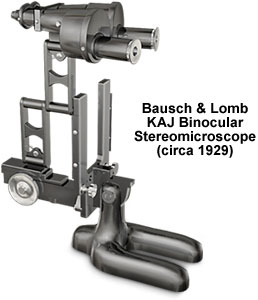Bausch & Lomb KAJ Binocular Stereomicroscope
The adjustable jointed arm of the Bausch & Lomb KAJ binocular stereomicroscope sets it apart from the competition. Providing versatility through an almost unlimited number of positions, the KAJ microscope offers a modicum of comfort via paired eyepieces that may be adjusted to suit the observer. In addition, the Greenough-style microscope forms an erect, apparently three-dimensional image of the specimen.

Shown extended, the horizontal position of the KAJ binocular body makes it suitable for observations through aquariums or for very large specimens that are typical of medical examinations and dissections. Wing nuts (not shown) on the hinged joint securely hold the microscope body in almost any desired position. The paired body tubes are actually a combination of two individual microscope tubes, each fitted with a centerable, achromatic objective having a range of magnification from 2.0x to 8.4x, and Huygenian eyepieces with several magnifications between 5x and 10x. The 5.6x and 8.4x power objectives feature compensation collars for the independent focusing of each of the paired lens systems.
A fixed, right angle prism positioned at the upper end of each tube, known as a Porro prism, is oriented so that there are two internal reflections, which result in an erect image inverted by 180 degrees. The eyepieces and prism housings may be rotated to match the exit pupils of the oculars to an observer's interpupillary distance. To ensure reduced optical aberration, the objectives and eyepieces are paired, matched to the microscope stand, and engraved with the microscope serial number. The one-piece, sliding base allows the microscopist to interchange paired objectives without disturbing the centering, focus, or specimen. Optical engineers at Bausch & Lomb created objectives with long working distances and large depth of field, making the KAJ binocular stereomicroscope well adapted for biological or medical work.
A 50-millimeter diameter plano-concave mirror (not illustrated) is mounted on a swinging arm and is adjustable for the optimal lighting of transparent specimens. Removable metal and glass plates (also not shown) top the metal stage and a very large rectangular aperture. For the ultimate in versatility, similar to other microscopes in the KA line, the microscope observation tube is removable and can be clamped, in a wide variety of positions, to a working surface, such as the optional 250-square millimeter board that fits over the stage.
For other configurations, the body tube and the entire arm can be removed from the basic Stand A and used on an alternative Bausch & Lomb microscope base, such as Stands KC, F, or E. The modified horseshoe base of Stand A is stylishly rounded in contour and provides stability through sound design and substantial mass. Focusing is accomplished by a diagonal rack and pinion mechanism that features relatively large brass, knurled knobs in improved, unobstructed positions, thus providing some ergonomic relief to the operator.
BACK TO TWENTIETH CENTURY BAUSCH & LOMB MICROSCOPES
BACK TO TWENTIETH CENTURY MICROSCOPES
